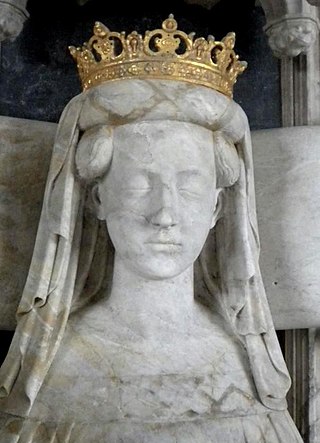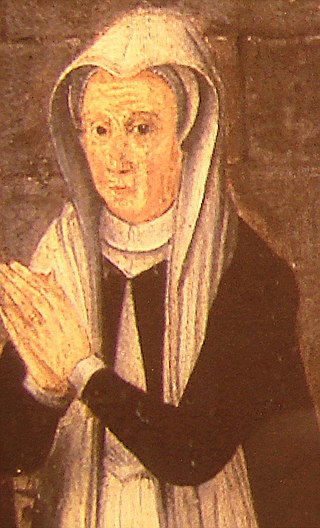Related Research Articles
Year 1358 (MCCCLVIII) was a common year starting on Monday of the Julian calendar.
Year 1399 (MCCCXCIX) was a common year starting on Wednesday of the Julian calendar.

Margaret I was Queen regnant of Denmark, Norway, and Sweden from the late 1380s until her death, and the founder of the Kalmar Union that joined the Scandinavian kingdoms together for over a century. She had been queen consort of Norway from 1363 to 1380 and of Sweden from 1363 to 1364 by marriage to Haakon VI. Margaret was known as a wise, energetic and capable leader, who governed with "farsighted tact and caution," earning the nickname "Semiramis of the North". Also famous derisively as "King Breechless", one of several derogatory nicknames once thought to have been invented by her rival King Albert of Sweden, she was also known by her subjects as "Lady King", which became widely used in recognition of her capabilities. Knut Gjerset calls her "the first great ruling queen in European history."

Ingeborg of Norway, was a Norwegian princess and by marriage a Swedish royal duchess with a position in the regency governments in Norway (1319–27) and Sweden (1319–26) during the minority of her son, King Magnus of Norway and Sweden. In 1318–1319, she was Sweden's de facto ruler, and from 1319 until 1326, she was Sweden's first de jure female regent. Her role in northern European history is considered of major importance.

Börringe Priory was a medieval Benedictine priory founded in 1150 at Svedala in Scania, Sweden. Secularized in 1536, the site was developed as a home for the Brahe family. The present large building, known as Börringeklosters slott, was built here in 1763.
Brita Olovsdotter Tott or Birgitte Olufsdatter Thott, was a Danish and Swedish noble, landowner and royal county administrator She was judged for treason and for the forgery of seals. She was one of the biggest landowners in Scandinavia, and her estates played a role in politics in Sweden and Denmark.
Mette Iversdotter Dyre was a Danish noble, nominal sheriff and chancellor. She was married three times to powerful men: two royal councillors and finally Svante, Regent of Sweden. As such she was a de facto queen consort. Mette Dyre is credited with political influence on the affairs of state through her spouse.
St. Agnes Priory was established by Queen Margaret I for a community of Dominican nuns at Gavnø Island. After the Danish Reformation the priory was transformed into a manor estate known as Gavnø Castle located near Næstved, Denmark.

Sophie Lykke was a Danish county administrator, landholder and noble.
Birgitte "Brita" Scheel(1638–1699), was a Danish noblewoman who married a Danish nobleman who became Swedish with the annexation of Denmark's eastern provinces. For that reason, Birgitte belongs both to Danish and Swedish history, and her family lives on in the now Swedish province of Scania (Skåne).
Sidsel Ulfstand, was a Danish (Scanian) landholder and county administrator.

Beate Clausdatter Bille was a Danish noblewoman, a member of the royal court, Chief Lady-in-Waiting to Queen Sophie from 1584 to 1592, the wife of statesman Otte Brahe, and a feudal fiefholder in her own right following the death of her husband. She succeeded her sister-in-law Inger Oxe, who held the office from 1572 to 1584, as chief lady-in-waiting to Queen Sophie. Beate Bille was the mother of astronomers Tycho Brahe and Sophia Brahe.

Gisselfeld, a former monastery, is Denmark's fifth-largest estate. Located between Haslev and Næstved, it extends into several municipalities but the main building is located in Braaby Parish in Faxe Municipality. The estate measures 3,850 hectares, including Hesede, Edelesminde, Brødebæk and Gødstrupgård, of which 2,400 hectares is forest. The three-storeyed Renaissance-style building has stepped gables, loopholes and a projecting tower over the main gate. The grounds include a moat, a well-kept park, lake, waterfall, gardens, greenhouse, and a fountain. A recent addition in its forest is a 45 meter tall hyperboloid tower.

Gladsaxehus is a ruined castle in Gladsax parish, in the Simrishamn Municipality of Skåne in south-eastern Sweden. The ruins lie immediately to the east of the church and cemetery of Gladsax.

Johanne Andersdatter Sappi, was a Danish noble and landholder, known as "Fru Johanne af Asdal". She became a well-known figure in the folklore of her country and the subject of folk songs and legend. According to traditional legend, she was a part of the council of state.
Ingerd Jakobsdatter, also called Ingerd af Regenstein (1200–1258) was a Danish noble, countess of Regenstein by marriage to count Konrad III of Regenstein. She established the Franciscan and Dominican order in Denmark, and was the founder of the female Franciscan abbey Skt. Clara Kloster af Damiani Orden.

The Witch trials in Denmark are poorly documented, with the exception of the region of Jylland in the 1609–1687 period. The most intense period in the Danish witchcraft persecutions was the great witch hunt of 1617–1625, when most executions took place, which was affected by a new witchcraft act introduced in 1617.
Events from the 14th century in Denmark.
Events from the 1390s in Denmark.
Steen Beck was a Danish landholder and government official. He served as royal treasurer from 1628 until his death. His holdings included the estates of Førslevgaard and Vibygård on the Danish island of Zealand.